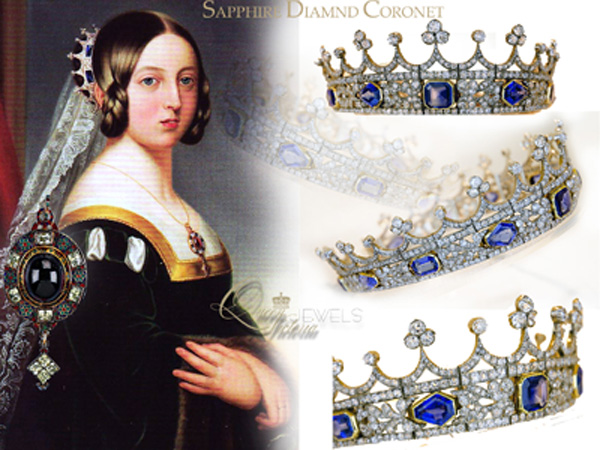The following story turned up in the mailing from the agency site Royal Central:
Queen Victoria's sapphire coronet
Image: The Natural Sapphire Company
The UK government have placed a temporary export ban on Queen Victoria’s coronet in an attempt to keep it in the country.
Queen
Victoria’s sapphire and diamond coronet is at risk of being exported
from UK soil unless a buyer can be found for the £5 million piece.
Designed
by Prince Albert in 1840, the coronet is considered one of the most
important jewels in Queen Victoria's reign. Goldsmith, James Kitching,
was paid £415 to make the coronet.
Following
Prince Albert’s death in 1861, Queen Victoria spent a great amount of
time in mourning and did not attend the State Opening of Parliament five
years later until 1866 where she wore the coronet instead of her
coronation crown.
Culture Minister Matt Hancock said: "Queen
Victoria’s coronet is stunning. It is one of the most iconic jewels
from a pivotal period in our history and symbolises one of our nation’s
most famous love stories. I hope that we are able to keep the coronet in
the UK and on display for the public to enjoy for years to come."
The
coronet was given as a present to Princess Mary upon her marriage to
Viscount Lascelles in 1922 by King George V and Queen Mary. Years later
it was sold to a dealer in London, who then sold it to the export
licence applicant.
The
export licence has however been deferred as a result of the coronet's
close connection with our history and natural life, according to the
Reviewing Committee on the Export of Works of Art and Objects of
Cultural Interest (RCEWA).
RCEWA member Philippa Glanville said: "Key
to the self-image of the young Victoria, this exquisite coronet was
designed by her husband Prince Albert. Worn in her popular state
portrait by Winterhalter of 1842, the year it was made, its combination
of personal meaning and formality explains why she chose to wear it in
1866, emerging from mourning for the State Opening of Parliament.
"It
evokes vividly the shared romantic taste of the time, and its form has
become familiar through many reproductions. Its departure would be a
great loss, given its beauty, its associations and its history."
The
export of the Coronet has been deferred until 27 December 2016. This
could be extended June 2017 if a serious intention of purchase can be
found.
An illustrated version of the same report from the BBC News website can be seen at Export ban placed on Queen Victoria's wedding coronet
The history of the coronet and the apparent background story about its appearance on the market is set out in a post on the Royal Musings blog at The last time Queen Victoria's Coronet was worn -- so what's the story
I would agree with the writer of that post that the coronet shold, and probably will, stau in this country and share her implicit questioning of what the Harewood family have done in selling this piece rather than offering it in settlement or coming to some arrangement with the Royal Collection.

The history of the coronet and the apparent background story about its appearance on the market is set out in a post on the Royal Musings blog at The last time Queen Victoria's Coronet was worn -- so what's the story
I would agree with the writer of that post that the coronet shold, and probably will, stau in this country and share her implicit questioning of what the Harewood family have done in selling this piece rather than offering it in settlement or coming to some arrangement with the Royal Collection.

Queen Victoria wearing the coronet
Image: royal-magazin.de


No comments:
Post a Comment